fire

 Some birthdays come and go without a lot of fanfare, but others come with a reminder of the blessings we have, and the things we could have lost. This year, for my niece, Kelli Schulenberg, hers is a birthday filled with reasons to be thankful. The recent fire that could have destroyed her home, also could have taken the life of her beloved dog, Dakota. While she was waiting to hear of the fate of her house, and the wellbeing of her dog, I had a chance to talk with, encourage, and pray with Kelli about the whole situation. Of course, her mind was filled with worry, but she showed a strength that told me that no matter what the outcome, she and my nephew Barry would pull through.
Some birthdays come and go without a lot of fanfare, but others come with a reminder of the blessings we have, and the things we could have lost. This year, for my niece, Kelli Schulenberg, hers is a birthday filled with reasons to be thankful. The recent fire that could have destroyed her home, also could have taken the life of her beloved dog, Dakota. While she was waiting to hear of the fate of her house, and the wellbeing of her dog, I had a chance to talk with, encourage, and pray with Kelli about the whole situation. Of course, her mind was filled with worry, but she showed a strength that told me that no matter what the outcome, she and my nephew Barry would pull through.
With Kelli’s birthday coming so close to Thanksgiving, I’m sure that there have been a number of years where her reasons for being thankful have mingled with her birthday wishes, but I doubt if any other year has brought that more into perspective than this year. When you come close to losing your home, your pet, and all of your cherished memories, it really serves as a reminder to be thankful for all God has given you, and all that He protected for you. Kelli and Barry’s home and their dog were spared, and they both know the feeling of thankfulness for that precious gift. The did lose some wood and trees, a trailer and a shed, but these were things that, while still a loss, can be replaced with much more ease than a home and less pain than a pet. Nevertheless, they were a loss.
But, as with most things we are thankful for, the best are the gifts given in our time of need. That certainly was the case for Kelli and Barry, when their family and friends came together to cut up more wood than they originally had. With the winter months set now with enough wood to keep their home warm and cozy, Kelli finds herself with yet another reason to be thankful the year, both on her birthday and Thanksgiving.
Some birthdays are a little bit sad, because we feel older now, or a loved one isn’t with us, but 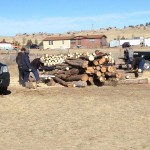
 I think that on this birthday, Kelli will not be thinking about the passing years, but rather about the blessings she has been given, especially in this past year. So much of her life could have been very different, had it not been for the prayers of friends and family, the hard work she and Barry had done to make sure their home had a good fire break around it, and the help of family and friends to give back the things lost. And of course, she is thankful to still have her dog, Dakota, thanks to the kindness of friends who made sure he was ok. Today is Kelli’s birthday. Happy birthday Kelli!! Have a great day!! We love you!!
I think that on this birthday, Kelli will not be thinking about the passing years, but rather about the blessings she has been given, especially in this past year. So much of her life could have been very different, had it not been for the prayers of friends and family, the hard work she and Barry had done to make sure their home had a good fire break around it, and the help of family and friends to give back the things lost. And of course, she is thankful to still have her dog, Dakota, thanks to the kindness of friends who made sure he was ok. Today is Kelli’s birthday. Happy birthday Kelli!! Have a great day!! We love you!!
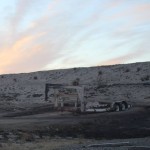
 On October 11, 2015, a wildfire devastated a large area north of Casper, including the area where my nephew, Barry Schulenberg and his wife, Kelli live. While their house was not one that was damaged, they did not escape unscathed. They lost a shed with some lawn equipment in it, fifteen or more trees, a flatbed trailer, and about eight cords of wood, which was enough to heat their home for the coming winter, just to name a few of the things. While insurance will reimburse them for some of the loss, it will not cover all of it, nor will it even begin to reimburse them for the many hours spent cutting all that wood the first time. And the hardest thing to get back…peace of mind.
On October 11, 2015, a wildfire devastated a large area north of Casper, including the area where my nephew, Barry Schulenberg and his wife, Kelli live. While their house was not one that was damaged, they did not escape unscathed. They lost a shed with some lawn equipment in it, fifteen or more trees, a flatbed trailer, and about eight cords of wood, which was enough to heat their home for the coming winter, just to name a few of the things. While insurance will reimburse them for some of the loss, it will not cover all of it, nor will it even begin to reimburse them for the many hours spent cutting all that wood the first time. And the hardest thing to get back…peace of mind.
People would call them lucky, that so much of their property was spared, but I don’t really think anyone who lost anything in that fire, that took 10,000 acres, 12 homes, a number of animals, and several other structures, considers themselves lucky…except that they made it out alive. I still don’t consider that luck. I believe it was the prayers of the people of Casper and others around the nation that kept the loss to the relative minimum that it ended up being, compared to other large fires.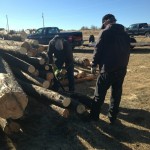

In the aftermath, many people have donated money and other needed items to those who suffered loss that dreadful day, and many will continue to do so. There is no way for me to talk about them all, but they know how much the people who they have helped appreciated it. Help after a loss never goes unnoticed. It is a show of love, kindness, and compassion that can never be repaid. People helping people…the giving spirit. It is what people do for those in need.
As for Barry and Kelli Schulenberg, a special family and friends benefit took place yesterday, when a dozen people converged on my brother-in-law and sister-in-law, Ron and Rachel Schulenberg’s place, where thankfully, Barry and Kelli still had some wood, waiting to be cut. Those dozen people spent most of the day cutting, loading, and unloading the ten cords of wood, that now sits where the first eight cords had been at Barry and Kelli’s place. I know that they already feel much better about the coming winter, because without all that wood, it would have been a much more expensive winter in the heating department.

 The things that Barry, Kelli, and the other fire victims lost in the fire will at least partially be replaced, but the thing you can’t put a value on is the helping hands of the people who stepped up to help you rebuild your life. The fire victims lost a lot of things, but things can be replaced. Nevertheless, cleanup, replanting, re-cutting of wood, and so many other things that had to be done after a fire, take time and effort. I have to give a lot of credit to anyone who helped to put the lives of the fire victims back together. The kindness of those helping hands was a blessing that will never be forgotten.
The things that Barry, Kelli, and the other fire victims lost in the fire will at least partially be replaced, but the thing you can’t put a value on is the helping hands of the people who stepped up to help you rebuild your life. The fire victims lost a lot of things, but things can be replaced. Nevertheless, cleanup, replanting, re-cutting of wood, and so many other things that had to be done after a fire, take time and effort. I have to give a lot of credit to anyone who helped to put the lives of the fire victims back together. The kindness of those helping hands was a blessing that will never be forgotten.
 I think most people have heard of the Great Chicago Fire of 1871, but few have heard of the Great Peshtigo Fire of 1871, that started the same day, October 8, 1871. I’m sure that Chicago, being a much bigger city, made it a fire that stuck in the minds of the people, but in reality, the Great Peshtigo Fire was far more deadly. The Chicago fire burned an area about four miles long and almost a mile wide through the Windy City, including its business district. The fire destroyed thousands of buildings, killed an estimated 300 people and caused an estimated $200 million in damages. That is a horrible fire, and a horrible loss of life and property, but it truly pales in comparison to the Great Peshtigo Fire. The Great Peshtigo Fire took place in the area around Peshtigo, Wisconsin and the death toll was estimated at around 1,500 people, and possibly as many as 2,500. I suppose that it seems odd for the estimate to be a difference of as many as a thousand people, but when the fire was finally out, twelve communities were destroyed. An accurate death toll has never been determined because local records were destroyed in the fire. Between 1,500 and 2,500 people are thought to have lost their lives. The 1873 Report to the Wisconsin Legislature listed 1,182 names of deceased or missing residents. In 1870, the Town of Peshtigo had 1,749 residents. More than 350 bodies were buried in a mass grave, primarily because so many had died that no one remained alive who could identify many of them. In the end, over, 1,875 square miles, or 1.2 million acres of forest had been consumed, an area approximately twice the size of Rhode Island. Some sources list 1.5 million acres burned.
I think most people have heard of the Great Chicago Fire of 1871, but few have heard of the Great Peshtigo Fire of 1871, that started the same day, October 8, 1871. I’m sure that Chicago, being a much bigger city, made it a fire that stuck in the minds of the people, but in reality, the Great Peshtigo Fire was far more deadly. The Chicago fire burned an area about four miles long and almost a mile wide through the Windy City, including its business district. The fire destroyed thousands of buildings, killed an estimated 300 people and caused an estimated $200 million in damages. That is a horrible fire, and a horrible loss of life and property, but it truly pales in comparison to the Great Peshtigo Fire. The Great Peshtigo Fire took place in the area around Peshtigo, Wisconsin and the death toll was estimated at around 1,500 people, and possibly as many as 2,500. I suppose that it seems odd for the estimate to be a difference of as many as a thousand people, but when the fire was finally out, twelve communities were destroyed. An accurate death toll has never been determined because local records were destroyed in the fire. Between 1,500 and 2,500 people are thought to have lost their lives. The 1873 Report to the Wisconsin Legislature listed 1,182 names of deceased or missing residents. In 1870, the Town of Peshtigo had 1,749 residents. More than 350 bodies were buried in a mass grave, primarily because so many had died that no one remained alive who could identify many of them. In the end, over, 1,875 square miles, or 1.2 million acres of forest had been consumed, an area approximately twice the size of Rhode Island. Some sources list 1.5 million acres burned.
The Peshtigo Fire was a forest fire that took place on October 8, 1871 in and around Peshtigo, Wisconsin. It was a firestorm that caused the most deaths by fire in United States history. A firestorm is a destructive fire which attains such intensity that it creates and sustains its own wind system. It is most commonly a natural phenomenon, created during some of the largest bushfires and wildfires. The biggest problem in 1871 was the 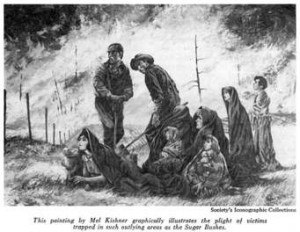 prolonged and widespread drought and high temperatures, capped off by a cyclonic storm in early October. The blaze began at an unknown spot in the dense Wisconsin forest. It first spread to the small village of Sugar Bush, where every resident was killed. There was simply no way of escape for them. High winds then sent the 200 foot flames racing northeast toward the neighboring community of Peshtigo. Temperatures reached 2,000 degrees Fahrenheit, causing trees to explode in the flames. The setting of small fires was a common way to clear forest land for farming and railroad construction. On the day of the Peshtigo Fire, a cold front moved in from the west, bringing strong winds that fanned the fires out of control and escalated them to massive proportions. A firestorm ensued. In the words of Novelist Denise Gess and historian William Lutz, “A firestorm is called nature’s nuclear explosion. Here’s a wall of flame, a mile high, five miles (8 km) wide, traveling 90 to 100 miles per hour (160 km/h), hotter than a crematorium, turning sand into glass.”
prolonged and widespread drought and high temperatures, capped off by a cyclonic storm in early October. The blaze began at an unknown spot in the dense Wisconsin forest. It first spread to the small village of Sugar Bush, where every resident was killed. There was simply no way of escape for them. High winds then sent the 200 foot flames racing northeast toward the neighboring community of Peshtigo. Temperatures reached 2,000 degrees Fahrenheit, causing trees to explode in the flames. The setting of small fires was a common way to clear forest land for farming and railroad construction. On the day of the Peshtigo Fire, a cold front moved in from the west, bringing strong winds that fanned the fires out of control and escalated them to massive proportions. A firestorm ensued. In the words of Novelist Denise Gess and historian William Lutz, “A firestorm is called nature’s nuclear explosion. Here’s a wall of flame, a mile high, five miles (8 km) wide, traveling 90 to 100 miles per hour (160 km/h), hotter than a crematorium, turning sand into glass.”
It would be impossible for most of us to imagine the way the people in that area felt that night. For so many of them, the way of escape, and with it, the hope of life disappeared in a matter of minutes. They didn’t know that the fire was coming until it had cut off their way of escape. Whole families were wiped out, and for the parents…well, I can’t imagine the sick feeling they had, knowing that they could not save their children. The fear the children must have felt, and the fear their parents shared with them…but, nothing could be done. They could only sit and wait for the end, trying not to speak the thoughts they were thinking…trying to give the children comfort and peace, even though their short lives were all they were going to get. So much has been learned over the years about drought and red flag (severe fire danger) days, but back then, they did not have the tools we have now, that can warn us of red flag situations, and even now, there are wildfires that destroy 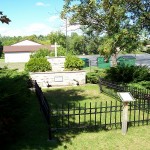 miles and miles of land, and with it towns and homes. If that can happen these days, I can only imagine how easily it could have happened then. Many people have called the Great Peshtigo Fire, the forgotten fire, but in recent years America’s “forgotten fire” has proven to be anything but. The tragedy is a subject of inquiry and debate among meteorologists, astronomers and conservationists. It has been dramatized by novelists and playwrights. It continues to fascinate history buffs and frustrate genealogists, which is where I come in. While the list of the dead from the Great Peshtigo Fire, does not include names I know to belong to my family, the idea of a thousand people unaccounted for in any way, makes me wonder if some of the Wisconsin connections I have been unable to make could be among the lost ones of the Great Peshtigo Fire.
miles and miles of land, and with it towns and homes. If that can happen these days, I can only imagine how easily it could have happened then. Many people have called the Great Peshtigo Fire, the forgotten fire, but in recent years America’s “forgotten fire” has proven to be anything but. The tragedy is a subject of inquiry and debate among meteorologists, astronomers and conservationists. It has been dramatized by novelists and playwrights. It continues to fascinate history buffs and frustrate genealogists, which is where I come in. While the list of the dead from the Great Peshtigo Fire, does not include names I know to belong to my family, the idea of a thousand people unaccounted for in any way, makes me wonder if some of the Wisconsin connections I have been unable to make could be among the lost ones of the Great Peshtigo Fire.
 Years ago, many people thought that anyone who was trying to invent an airplane was pretty much insane…saying, that “if man were meant to fly, God would have given him wings” as their reasoning. I’m sure that those same people reiterated their thoughts on the matter, with each new plane crash…basically jumping on the chance to say, “I told you so!” Of course, these days, no one thinks that way, whether they like to fly or not. I guess a fear of flying and the idea that it is a foolish pipe dream aren’t the same things at all. Still, while man has proven over the years that flight is possible, and in fact mostly safe, there are some airplane crashes that that will forever be embedded in our minds. For me, of course, the one that I can picture in my mind at the drop of a hat, is Flight 232 that crashed in Sioux City, Iowa. This was the crash that took the life of my Great Aunt Gladys Pattan Byer Cooper. That pilot was so close to landing that plane safely, and would have, in fact, if the plane hadn’t put in one last effort to turn over due to a major loss of hydraulics. The resulting crash made me wonder how anyone survived…much less the 185 out of 296 people on board. The only reason they survived was the skill of the pilot…and much prayer.
Years ago, many people thought that anyone who was trying to invent an airplane was pretty much insane…saying, that “if man were meant to fly, God would have given him wings” as their reasoning. I’m sure that those same people reiterated their thoughts on the matter, with each new plane crash…basically jumping on the chance to say, “I told you so!” Of course, these days, no one thinks that way, whether they like to fly or not. I guess a fear of flying and the idea that it is a foolish pipe dream aren’t the same things at all. Still, while man has proven over the years that flight is possible, and in fact mostly safe, there are some airplane crashes that that will forever be embedded in our minds. For me, of course, the one that I can picture in my mind at the drop of a hat, is Flight 232 that crashed in Sioux City, Iowa. This was the crash that took the life of my Great Aunt Gladys Pattan Byer Cooper. That pilot was so close to landing that plane safely, and would have, in fact, if the plane hadn’t put in one last effort to turn over due to a major loss of hydraulics. The resulting crash made me wonder how anyone survived…much less the 185 out of 296 people on board. The only reason they survived was the skill of the pilot…and much prayer.
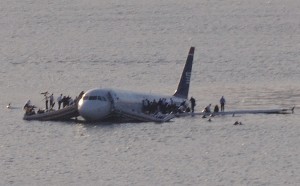
Another plane crash that has stayed in my memory was the crash of the Concorde, that occurred on this day, July 25, 2000. The Concord was a beautiful plane, and by far the most luxurious one of its time. I’m not sure there are even any planes that are more luxurious today…although the Boeing 787 might be. Dubbed the Dreamliner, it gives the indication that it might out class the Concorde. Nevertheless, in its day, the Concorde was the end all, beat all of airplanes. The thing that always amazes me is that sometimes it is the tiniest of things that ends up bringing down a plane. Much like the bird strike that brought down US Airways Flight 1549 on the Hudson River.
The Concorde was downed be a small piece of metal on the runway…that had fallen off of another plane. Air France Flight 4590 left DE Gaulle Airport for New York carrying nine crew members and 96 German tourists who were planning to take a cruise to Ecuador. That piece of metal shredded the tire that ran over it, throwing  pieces of the tire into one of the engines and fuel tanks, causing a disabling fire. The pilot had no idea what was about to happen, but just moments later the plane plunged to the ground near a hotel in Gonesse, France. A huge fireball erupted and all 105 people on the plane were killed immediately. The Concorde, the world’s fastest commercial jet, had enjoyed an exemplary safety record up to that point, with no crashes in the plane’s 31 year history. That crash, however, marked the beginning of the end for the Concorde. The last flight of the Concorde was on October 24, 2003. What was supposed to mark the first of a future of supersonic, fast paced air travel, was brought to a disappointing halt. Air travel has taken on a much slower pace since that time.
pieces of the tire into one of the engines and fuel tanks, causing a disabling fire. The pilot had no idea what was about to happen, but just moments later the plane plunged to the ground near a hotel in Gonesse, France. A huge fireball erupted and all 105 people on the plane were killed immediately. The Concorde, the world’s fastest commercial jet, had enjoyed an exemplary safety record up to that point, with no crashes in the plane’s 31 year history. That crash, however, marked the beginning of the end for the Concorde. The last flight of the Concorde was on October 24, 2003. What was supposed to mark the first of a future of supersonic, fast paced air travel, was brought to a disappointing halt. Air travel has taken on a much slower pace since that time.

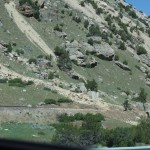 For a number of years now, Bob and I have made a trip to Thermopolis each year in early March in celebration of our wedding anniversary, which is March 1st. Driving through the Wind River Canyon that many times, I feel like I know the face of those canyon walls pretty well. Since rainy weather has dominated this Spring, many areas of the state of Wyoming and several other states, flooding is a word that we have all gotten used to hearing. Since our state has been in a relative draught for a number of years, the ground has had a hard time absorbing all that water that has been coming in. And then there is the fact that we have had a few fires in key areas around the state. That adds an additional danger to certain areas…one of which is the Wind River Canyon, which was hit with mudslides and rockslides earlier this year.
For a number of years now, Bob and I have made a trip to Thermopolis each year in early March in celebration of our wedding anniversary, which is March 1st. Driving through the Wind River Canyon that many times, I feel like I know the face of those canyon walls pretty well. Since rainy weather has dominated this Spring, many areas of the state of Wyoming and several other states, flooding is a word that we have all gotten used to hearing. Since our state has been in a relative draught for a number of years, the ground has had a hard time absorbing all that water that has been coming in. And then there is the fact that we have had a few fires in key areas around the state. That adds an additional danger to certain areas…one of which is the Wind River Canyon, which was hit with mudslides and rockslides earlier this year.
This morning, Bob and I decided to take a drive up to Thermopolis to see for ourselves, exactly how the canyon face had been changed by the mudslides. Our granddaughter, Shai Royce decided to come along to see it too. 
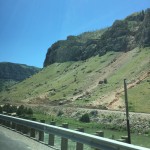 We had seen the pictures of it on television and on the internet when it happened, but you really can’t get a clear picture of something like that until you see it up close. So, after breakfast we set out. It was a nice drive up to the Wind River Canyon, and at first, it didn’t look so different, but then we got to the area where the main slides were. It was much different.
We had seen the pictures of it on television and on the internet when it happened, but you really can’t get a clear picture of something like that until you see it up close. So, after breakfast we set out. It was a nice drive up to the Wind River Canyon, and at first, it didn’t look so different, but then we got to the area where the main slides were. It was much different.
I expected it to look different, and it did, but what I didn’t expect was to have it occur to me that I was looking at the changing face of the canyon. I thought about how the canyon had changed over the years of its existence. The river made most of the changes that had taken place, slowly carving out the depth of it with erosion. Soon, its walls were high and filled with the hard rocks that had survived the erosion process. The trees grew along the face of the walls, and in time we all thought it wouldn’t change much, but rock and mudslides can change the face of those canyon walls overnight. I found myself thinking about how easy it was to pick out the slide path of each 
 slide area. The coloring of the upturned earth made it stand out as if it were florescent paint. I was able to see the complete path the mud and rocks took on their way down.
slide area. The coloring of the upturned earth made it stand out as if it were florescent paint. I was able to see the complete path the mud and rocks took on their way down.
I realized that this was just one event, but it didn’t matter, because I was looking at the changes brought about by time. This was the canyon’s changing face, caused by the effects of weather, water, wind, and fire to bring about an entirely new look to a canyon that had been there so long, looking, or so I thought, always the same. In reality, it was ever changing.
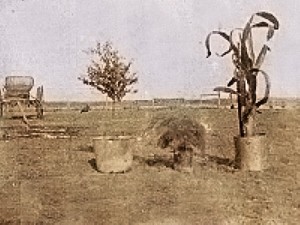
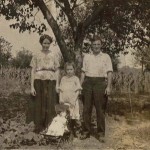 I have often wondered what our nation looked like before the Native Americans altered the landscape with the only way they really had of clearing the land…fire. When the summer grasslands would grow so tall that it made travel by horse or on foot troublesome, the Indians just started a fire to clear the area. Since there was nothing standing in the way of the fire, it ran until it came to a river or some other kind of obstacle, such as an area void of vegetation, and then it simply burned itself out. Of course, rain or snow would have the same effect too. I wonder, like many other people do, if prior to that practice, there were forests where we now have plains.
I have often wondered what our nation looked like before the Native Americans altered the landscape with the only way they really had of clearing the land…fire. When the summer grasslands would grow so tall that it made travel by horse or on foot troublesome, the Indians just started a fire to clear the area. Since there was nothing standing in the way of the fire, it ran until it came to a river or some other kind of obstacle, such as an area void of vegetation, and then it simply burned itself out. Of course, rain or snow would have the same effect too. I wonder, like many other people do, if prior to that practice, there were forests where we now have plains.
Of course, the White Man, has come a long way in trying to bring trees back into our nation, but there are still many places that are just wide open spaces filled with prairie grass, sagebrush, and cactus. When my grandparents, Anna and Allen Spencer decided to move to Texas to check out the booming oil industry, they found a land that seemed to run for hundreds of miles, with little to see, but wide open spaces. Like many people, they longed for trees, and other vegetation to give a different view to the land they found themselves living on. Having lived on five acres myself for a number of years before moving into town, I can certainly understand wanting trees. That didn’t make it easy to grow any of them up to much size, however. I suppose it 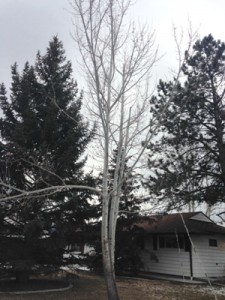 might have been easier in Texas, due to their warmer climate.
might have been easier in Texas, due to their warmer climate.
I understand the need Native Americans had to clear the land, and the lack of sufficient tools to do so, when it was necessary. Nevertheless, I wish they had not burned down the trees…or the prairies, because that stopped the young trees from growing, and lets face it…we need trees for shade, and the very air we breathe. These days, with all the necessary tools, from lawnmowers to farm equipment, there is no need to burn down the prairie grass to keep it from getting so deep, so clearing the land is a much smoother project. The older I get, the more I find myself wanting trees around me, and while it is still hard to get them up to some size, due mainly to the deer that roam freely inside the city limits of Casper, Wyoming, I do have some volunteer Silver Birch trees that have moved themselves from the neighbors tree into our yard.
We were so excited when the first tree started coming up, but our neighbor, Bill thought we would be upset about the little trespassing trees, and so he cut the down…until we told him that we wanted them. Then he left them alone so we could decide to let them grow or not. That first tree is now taller that our house, and we have several in the back yard too. Before these trees began growing, we had three cedar bushes in our front yard, one that was let grow to the size of a rather ugly tree. Finally, the day came that we got one of those little trespassing trees to come up in the right place. While we liked the bushes, that ugly Cedar tree needed to go. Then that tree got to an area where it could work for what we wanted. This past summer, it had grown to the 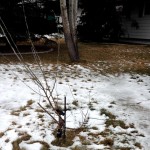
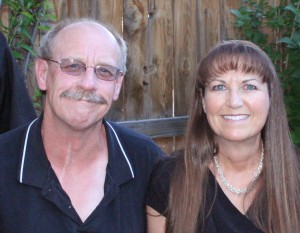 point of being about my height. Life was good. We cut down that ugly Cedar bush that had been pretending to be a tree, and watch with excitement as our new little trespassing tree grew and flourished…and then it happened. The deer that I love to have in our yard, because they are so beautiful…decided that our little tree was just the right size for lunch. It’s hard to say if it will come back in the spring, but if not, there will be another little trespasser to grow in its place…life is still good!!!
point of being about my height. Life was good. We cut down that ugly Cedar bush that had been pretending to be a tree, and watch with excitement as our new little trespassing tree grew and flourished…and then it happened. The deer that I love to have in our yard, because they are so beautiful…decided that our little tree was just the right size for lunch. It’s hard to say if it will come back in the spring, but if not, there will be another little trespasser to grow in its place…life is still good!!!
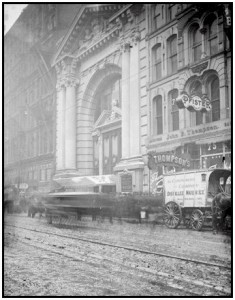 Every day, we benefit from safety measures that have been put in place as a result of a need, or more often a tragedy, that occurred in the past. We give very little thought to things like fire drills, earthquake drills, or even the fire extinguisher on the wall in buildings. We don’t normally think about the fire exit, unless we are looking for the way out of a building and find that this exit is only to be used in case of a fire. I suppose that the reason we don’t think of these things is that we expect the place we are in to be a safe place. There are regulations surrounding the public use of buildings that require that the building meet a certain standard of safety, and most often they do…these days anyway.
Every day, we benefit from safety measures that have been put in place as a result of a need, or more often a tragedy, that occurred in the past. We give very little thought to things like fire drills, earthquake drills, or even the fire extinguisher on the wall in buildings. We don’t normally think about the fire exit, unless we are looking for the way out of a building and find that this exit is only to be used in case of a fire. I suppose that the reason we don’t think of these things is that we expect the place we are in to be a safe place. There are regulations surrounding the public use of buildings that require that the building meet a certain standard of safety, and most often they do…these days anyway.
These safety lessons were not so pleasant to learn for those who came before us and who didn’t survive. Such was the case on December 30, 1903, when the Iroquois Theater in Chicago caught fire and killed 602 people, 572 inside the theater, with the rest dying of the injuries received in the fire. That total included 212 children. You see, the Iroquois Theater was hosting hundreds of adults and school children to a Holiday performance of a play starring the popular comedian, Eddie Foy. The sad thing is that the theater was thought to be fireproof. In reality it was a deathtrap, due to so many safety violations. As a result, the lives of many families were devastated. As I looked at the list of victims, I can’t say that I ran across any I knew to belong in my family tree, but I could be wrong on that too. My family and that of my husband, Bob, spent a lot of time in the Great  Lakes area, so it is entirely possible that my own family lost people due to this tragedy as well.
Lakes area, so it is entirely possible that my own family lost people due to this tragedy as well.
These days, our children think nothing of a fire alarm going off in school. They have several of them a year. when the alarm goes off, they simply follow their training and line up to leave the building. If there were a fire, they would most likely not know it until they were not allowed to go back into the building. Children in earthquake prone areas at taught exactly what to do if the room starts shaking, and they respond automatically, often saving their lives.
The problem with the Iroquois Theater fire, was as simple as the problem with the Titanic. People didn’t think the building could possible burn, or the ship sink. The Iroquois Theater was only open five weeks before it’s total destruction. As a result, lives were lost. In my reading of this tragedy, I found that while the architect wanted every possible safety measure taken, costs had been cut and therefore, the fireproof theater everyone thought they were in, simply did not exist. The theater was over crowded by 400 people, at 2,000 people in a theater designed to hold 1,600. They stairway to the fire escape hadn’t been finished yet. exit doors had been designed to be pulled open, and with the crowd of fear stricken people, the press was to much, and the escape, completely blocked. Iron gates closing off some of the stairways were locked, and people tried jumping out the window…to their deaths unfortunately. In some  places the bodies were stacked 10 high with people attempting to crawl over each other to get out. In desperation the fire department set up a bridge of sorts to get people out. Some got out, some didn’t.
places the bodies were stacked 10 high with people attempting to crawl over each other to get out. In desperation the fire department set up a bridge of sorts to get people out. Some got out, some didn’t.
I don’t know why we humans always seem to think that something we build could be indestructible, when in reality, much of what we build is, in one way or another, flawed. I think that one of the best things we can do for our families, is to make sure they all know how to get out of a building safely. We can hope that the architect, contractor, workers, and inspectors all did their job properly, but we must remember that they are only human too, and mistakes can be made. If people know not to panic, they can get out safely more times than not, but panic…most often results in tragedy. And that is what happened in the Iroquois Theater in Chicago on December 30, 1903…panic and a complete disregard for the elementary rules of safety.
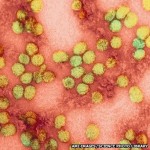 When I come across a husband and wife, who both died on the same day, my curiosity kicks into overdrive. That just seems so unusual. Nevertheless, such was the case for my husband, Bob’s 4th great grandparents, Cloudsbury and Elizabeth Kirby, both of whom died on August 29, 1878 in Mount Ayr, Ringgold County, Iowa. At first, I wondered if it was an error, and I suppose it could be, but that is the information I have at this point, so that is what I have to go with.
When I come across a husband and wife, who both died on the same day, my curiosity kicks into overdrive. That just seems so unusual. Nevertheless, such was the case for my husband, Bob’s 4th great grandparents, Cloudsbury and Elizabeth Kirby, both of whom died on August 29, 1878 in Mount Ayr, Ringgold County, Iowa. At first, I wondered if it was an error, and I suppose it could be, but that is the information I have at this point, so that is what I have to go with.
My first thought was to check for disasters in the area, like tornados, fires, or floods, but I was unable to find anything that specifically happened in Mount Ayr, Iowa on August 29, 1878. Looking for these kinds of specific things can be a long and frustrating process, but I just can’t imagine too many situations where both halves of a couple would pass on the same day. I searched and found that there were tornadoes during that year, but nothing specifically on that day, so I doubt that a tornado is the culprit here.
When the possibility of a disaster was removed, I began to think about illness, so I looked up and epidemics in the area. That is when I came across a definite possibility…the Yellow Fever Epidemic of 1876 to 1878, which took many lives in the southern United States. Yellow fever, known historically as yellow jack or yellow plague is an acute viral disease, that is usually spread by the female mosquito. Symptoms include fever, chills, loss of appetite, nausea, muscle pains particularly in the back, and headaches. Many people improve after a few days, but when the symptoms return, they can cause kidney damage, liver failure (causing yellow skin, probably the reason for the name Yellow Fever), bleeding, and ultimately death. These days there is a vaccine against Yellow Fever and some countries require it for travelers. Other countries try to control the virus by killing off as many mosquitoes as possible. Nevertheless, Yellow Fever causes 200,000 infections and 30,000 deaths every year with nearly 90% of those occurring in Africa, these days. Since the 17th century, several major outbreaks have occurred in America, Africa, and Europe. In the 18th and 19th centuries yellow fever was seen as the most dangerous of infectious diseases.
I can’t say for sure that Yellow Fever is what took the lives of Bob’s 4th great grandparents, but with the epidemic that occurred during that time, I have to think that it is a possibility. I have looked at the lists of people know to have died of Yellow Fever during that epidemic, and did not see Cloudsbury and Elizabeth Kirby on the list, but the list was incomplete, with many people only listed as a number. At this time, unless more information somehow surfaces, I will probably never know for sure, but the epidemic, which apparently came in from Cuba caused 100,000 people to become ill, and killed 20,000 people, so it is likely that they were too busy, trying to help people get better, to keep really great records as to the names of the dead. I have to feel really sorry for people of that time. They didn’t really know what was causing the epidemic and would not have had a way to do much about it anyway, so many lives were lost. Thankfully for the people of this century, Yellow Fever can be prevented by vaccination, and it is usually found in Africa, so we don’t really see much of it here.
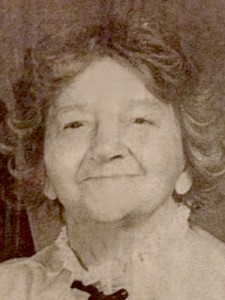 As I was reading the notes I was given on Frederick Schumacher and his wife, Anna Richard Schumacher, I read that they lost their home to a fire in 1956. I can’t imagine losing your home and all of your precious memories in a fire, and yet it does happen. I don’t know what memories Fred and Anna lost, but my guess is that it included photographs of their babies as they grew up. Those are things that are so hard to get back. All you can do is hope that someone among your friends and family members has pictures they can share with you. I’m sure it was such a shock…everything was gone…in an instant. All you had left was your family and the clothes on your back…and you were grateful. How could you feel gratitude after such a devastating loss? Of course, it is because your family had survived, and in reality, everything else is just stuff. Nevertheless, as time goes by, you begin to realize that you really lost a lot that dreadful day. It’s no wonder you seem to be having a hard time getting past it. I have to wonder if sleeping at night is difficult, because you feel a deep need to be on your guard. Still, you have to move forward for your family.
As I was reading the notes I was given on Frederick Schumacher and his wife, Anna Richard Schumacher, I read that they lost their home to a fire in 1956. I can’t imagine losing your home and all of your precious memories in a fire, and yet it does happen. I don’t know what memories Fred and Anna lost, but my guess is that it included photographs of their babies as they grew up. Those are things that are so hard to get back. All you can do is hope that someone among your friends and family members has pictures they can share with you. I’m sure it was such a shock…everything was gone…in an instant. All you had left was your family and the clothes on your back…and you were grateful. How could you feel gratitude after such a devastating loss? Of course, it is because your family had survived, and in reality, everything else is just stuff. Nevertheless, as time goes by, you begin to realize that you really lost a lot that dreadful day. It’s no wonder you seem to be having a hard time getting past it. I have to wonder if sleeping at night is difficult, because you feel a deep need to be on your guard. Still, you have to move forward for your family.
A fire affects everyone in the family…even grown children who have homes of their own. When  fire destroyed my Uncle Jim Wolfe’s home on Wolfe Mountain outside of Newport, Washington, there was no way to get help up there in time. The road is just too rough and the area too remote to get fire trucks up there, so when Uncle Jim’s home caught fire, the only thing they could do was to try to save what they could…and it was not much. All of the memories were lost…pictures, keepsakes from my Aunt Ruth’s life, all of the pictures of the childhood days of my cousins, as well as all of Uncle Jim’s items for day to day living. Before long, Uncle Jim needed to move into a nursing home where he could get 24 hour care for his Alzheimer’s Disease. For my cousin, Shirley it was like losing one more of her precious memories…having her dad living just down the road from her. Her mother, my Aunt Ruth had passed away, in 1992, and this was just one more blow to Shirley.
fire destroyed my Uncle Jim Wolfe’s home on Wolfe Mountain outside of Newport, Washington, there was no way to get help up there in time. The road is just too rough and the area too remote to get fire trucks up there, so when Uncle Jim’s home caught fire, the only thing they could do was to try to save what they could…and it was not much. All of the memories were lost…pictures, keepsakes from my Aunt Ruth’s life, all of the pictures of the childhood days of my cousins, as well as all of Uncle Jim’s items for day to day living. Before long, Uncle Jim needed to move into a nursing home where he could get 24 hour care for his Alzheimer’s Disease. For my cousin, Shirley it was like losing one more of her precious memories…having her dad living just down the road from her. Her mother, my Aunt Ruth had passed away, in 1992, and this was just one more blow to Shirley.
Fires destroy the dreams, as well as the memories, of those who have an unfortunate encounter with them. For my cousin, Shirley, it has meant trying to find friends and family  who might have childhood pictures that they could copy for her. We have been searching for pictures, but have not found a whole lot for her. I am still hopeful that someday we will stumble across a huge cache of pictures that will fill all the memory holes in her life right now. It is amazing to me that in this day and age, we are still unable to save some homes from fire. It’s not so much a remote home, like my Uncle Jim’s, but even homes in town, are completely destroyed be fire. Still there are factors like how long it took to report, and what type of fire it was that can affect the ability to save it too. Whatever the reason, dreams and memories are lost in the twinkling of an eye, and they are really hard to get back.
who might have childhood pictures that they could copy for her. We have been searching for pictures, but have not found a whole lot for her. I am still hopeful that someday we will stumble across a huge cache of pictures that will fill all the memory holes in her life right now. It is amazing to me that in this day and age, we are still unable to save some homes from fire. It’s not so much a remote home, like my Uncle Jim’s, but even homes in town, are completely destroyed be fire. Still there are factors like how long it took to report, and what type of fire it was that can affect the ability to save it too. Whatever the reason, dreams and memories are lost in the twinkling of an eye, and they are really hard to get back.

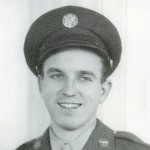 Every soldier who ever signed up had to go through a few moments of fear or worry about where the steps they were taking were going to lead them. Whether they signed up voluntarily, or were drafted, there was always the possibility, or in many cases, the probability that they would soon find themselves fighting and killing men, or boys really, who were the same age or even younger than they were. In early wars, the fighting was hand to hand, and even when guns were invented, they often saw the result of their direct hit on the enemy. They witnessed the fear, so vividly evident on the face of that person who was the enemy, and yet was really no different than they were. Both men were scared. It truly was kill or be killed, because it was war, and the only objective was to win.
Every soldier who ever signed up had to go through a few moments of fear or worry about where the steps they were taking were going to lead them. Whether they signed up voluntarily, or were drafted, there was always the possibility, or in many cases, the probability that they would soon find themselves fighting and killing men, or boys really, who were the same age or even younger than they were. In early wars, the fighting was hand to hand, and even when guns were invented, they often saw the result of their direct hit on the enemy. They witnessed the fear, so vividly evident on the face of that person who was the enemy, and yet was really no different than they were. Both men were scared. It truly was kill or be killed, because it was war, and the only objective was to win.
Many of my ancestors have been in wars, including most recently, my dad, brothers-in-law, several uncles, nephews, and grandfathers. I have read some of my dad’s letters home from the war, and while he tried to sound positive and unafraid, you could still see, if you read between the lines, that war and a degree of fear simply went together. Still, I can imagine that as each of those men and women are standing in line to get the many vaccinations they had to have, that for a least a moment, they wondered just what they had gotten themselves into. Of course, there was really no way out. It didn’t matter if they enlisted voluntarily or were drafted, they belonged to Uncle Sam either way. They were going into battle, and that’s all there is too it.
Of course, the soldier is trained to be brave and not to show fear, and maybe they truly have to do that. I know that if you show fear to a dog, they pick up on that…so does the enemy too…maybe. All I know is that deep in their hearts, they must feel like they would like to run in the face of enemy fire. Of course, they can’t. They must fight. This is war…this is kill or be killed…this is their duty, and even if it means that they lose their life, they must do their duty. People are depending on them. Not just their platoon members, but their nation, and the people of the nation they are trying to protect from whatever evil people are trying to take them over.
When I think of our soldiers, I have to think of how very brave and courageous they are, 
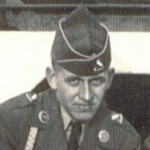 because as the saying goes, “I learned that courage was not the absence of fear, but the triumph over it. The brave man is not he who does not feel afraid, but he who conquers that fear.” I feel very proud of all those men and women in our family, as well as our friends, who have answered the call to duty, set aside their fears, and gone out to do their duty in the fight against evil. They are a huge part of what makes this country great.
because as the saying goes, “I learned that courage was not the absence of fear, but the triumph over it. The brave man is not he who does not feel afraid, but he who conquers that fear.” I feel very proud of all those men and women in our family, as well as our friends, who have answered the call to duty, set aside their fears, and gone out to do their duty in the fight against evil. They are a huge part of what makes this country great.

